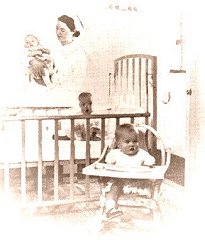It had been in the minds of those engaged in anti-tuberculosis work in the Sanatorium for some time to establish some department where tuberculous mothers could be confined and where the offspring could be well looked after apart from her, and she could at the same time continue her treatment. Before the times of these such treatment centers expectant mothers who were taking treatment in the institution returned home for their confinements where the baby was in all probability freely exposed to the disease, and returned here afterwards probably in far poorer health to continue their treatment. In some cases finding it difficult to leave the baby to the tender mercies of relatives, the mother stayed at home in order to keep her home going and probably made her own health much worse.
Then, in 1913, the first preventorium in North America was opened north of Toronto, at the Weston sanatorium. The object of the establishment of a preventorium was to prevent infection of the next generation and to carry the mothers over a critical time in the history of their disease. The preventorium consisted of a maternity ward with a balcony for the mother to continue her treatment, and a larger ward adjoining where the babies were looked after and yet were quite isolated from the mothers.
The mother was taken up to the maternity ward until the completion of her pregnancy. Immediately following the motherís confinement, the baby was moved into the next ward and had no means of contact with the mother. As soon as the motherís conditions allowed, she was transferred back to her pavilion or infirmary where she had been taking treatment before, and the baby was taken care of in its own department.
At first sight it may have seemed a hard and unnatural separation for mothers, but once the conditions were explained, it was not difficult to convince a mother that this way everything possible was being done for the future welfare of her baby as well as for herself.
| 


